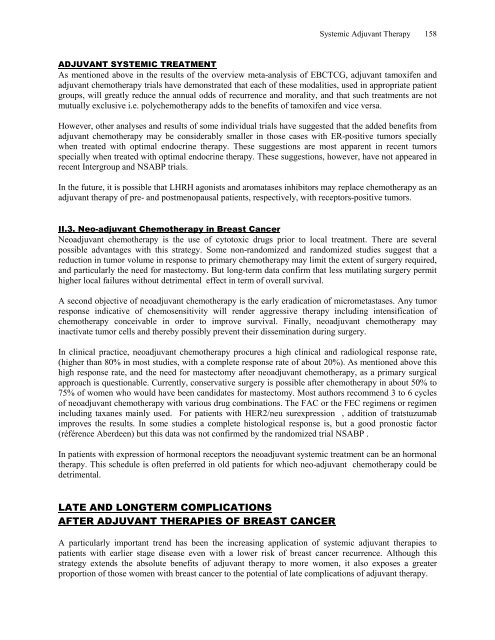Breast Cancer - Arab Medical Association Against Cancer
Breast Cancer - Arab Medical Association Against Cancer
Breast Cancer - Arab Medical Association Against Cancer
- No tags were found...
Create successful ePaper yourself
Turn your PDF publications into a flip-book with our unique Google optimized e-Paper software.
Systemic Adjuvant Therapy 158ADJUVANT SYSTEMIC TREATMENTAs mentioned above in the results of the overview meta-analysis of EBCTCG, adjuvant tamoxifen andadjuvant chemotherapy trials have demonstrated that each of these modalities, used in appropriate patientgroups, will greatly reduce the annual odds of recurrence and morality, and that such treatments are notmutually exclusive i.e. polychemotherapy adds to the benefits of tamoxifen and vice versa.However, other analyses and results of some individual trials have suggested that the added benefits fromadjuvant chemotherapy may be considerably smaller in those cases with ER-positive tumors speciallywhen treated with optimal endocrine therapy. These suggestions are most apparent in recent tumorsspecially when treated with optimal endocrine therapy. These suggestions, however, have not appeared inrecent Intergroup and NSABP trials.In the future, it is possible that LHRH agonists and aromatases inhibitors may replace chemotherapy as anadjuvant therapy of pre- and postmenopausal patients, respectively, with receptors-positive tumors.II.3. Neo-adjuvant Chemotherapy in <strong>Breast</strong> <strong>Cancer</strong>Neoadjuvant chemotherapy is the use of cytotoxic drugs prior to local treatment. There are severalpossible advantages with this strategy. Some non-randomized and randomized studies suggest that areduction in tumor volume in response to primary chemotherapy may limit the extent of surgery required,and particularly the need for mastectomy. But long-term data confirm that less mutilating surgery permithigher local failures without detrimental effect in term of overall survival.A second objective of neoadjuvant chemotherapy is the early eradication of micrometastases. Any tumorresponse indicative of chemosensitivity will render aggressive therapy including intensification ofchemotherapy conceivable in order to improve survival. Finally, neoadjuvant chemotherapy mayinactivate tumor cells and thereby possibly prevent their dissemination during surgery.In clinical practice, neoadjuvant chemotherapy procures a high clinical and radiological response rate,(higher than 80% in most studies, with a complete response rate of about 20%). As mentioned above thishigh response rate, and the need for mastectomy after neoadjuvant chemotherapy, as a primary surgicalapproach is questionable. Currently, conservative surgery is possible after chemotherapy in about 50% to75% of women who would have been candidates for mastectomy. Most authors recommend 3 to 6 cyclesof neoadjuvant chemotherapy with various drug combinations. The FAC or the FEC regimens or regimenincluding taxanes mainly used. For patients with HER2/neu surexpression , addition of tratstuzumabimproves the results. In some studies a complete histological response is, but a good pronostic factor(référence Aberdeen) but this data was not confirmed by the randomized trial NSABP .In patients with expression of hormonal receptors the neoadjuvant systemic treatment can be an hormonaltherapy. This schedule is often preferred in old patients for which neo-adjuvant chemotherapy could bedetrimental.LATE AND LONGTERM COMPLICATIONSAFTER ADJUVANT THERAPIES OF BREAST CANCERA particularly important trend has been the increasing application of systemic adjuvant therapies topatients with earlier stage disease even with a lower risk of breast cancer recurrence. Although thisstrategy extends the absolute benefits of adjuvant therapy to more women, it also exposes a greaterproportion of those women with breast cancer to the potential of late complications of adjuvant therapy.









